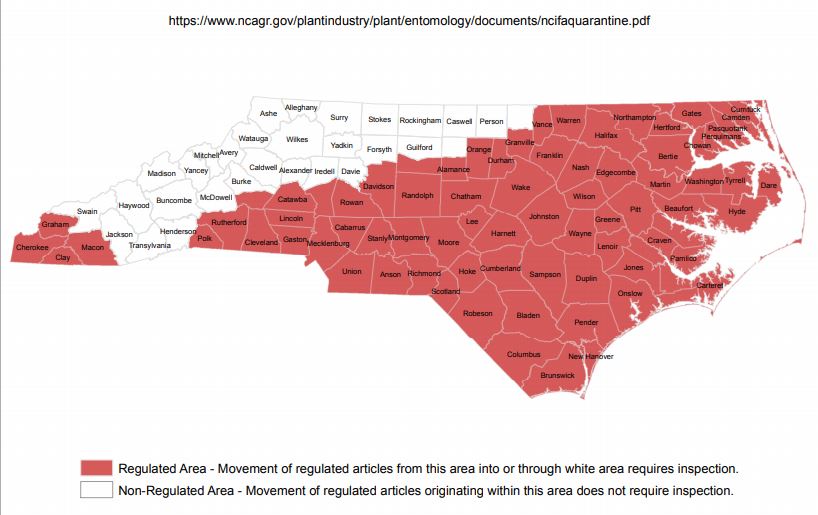Hay Imported From a “Red” County Must Be Inspected
go.ncsu.edu/readext?692246
en Español / em Português
El inglés es el idioma de control de esta página. En la medida en que haya algún conflicto entre la traducción al inglés y la traducción, el inglés prevalece.
Al hacer clic en el enlace de traducción se activa un servicio de traducción gratuito para convertir la página al español. Al igual que con cualquier traducción por Internet, la conversión no es sensible al contexto y puede que no traduzca el texto en su significado original. NC State Extension no garantiza la exactitud del texto traducido. Por favor, tenga en cuenta que algunas aplicaciones y/o servicios pueden no funcionar como se espera cuando se traducen.
Português
Inglês é o idioma de controle desta página. Na medida que haja algum conflito entre o texto original em Inglês e a tradução, o Inglês prevalece.
Ao clicar no link de tradução, um serviço gratuito de tradução será ativado para converter a página para o Português. Como em qualquer tradução pela internet, a conversão não é sensivel ao contexto e pode não ocorrer a tradução para o significado orginal. O serviço de Extensão da Carolina do Norte (NC State Extension) não garante a exatidão do texto traduzido. Por favor, observe que algumas funções ou serviços podem não funcionar como esperado após a tradução.
English
English is the controlling language of this page. To the extent there is any conflict between the English text and the translation, English controls.
Clicking on the translation link activates a free translation service to convert the page to Spanish. As with any Internet translation, the conversion is not context-sensitive and may not translate the text to its original meaning. NC State Extension does not guarantee the accuracy of the translated text. Please note that some applications and/or services may not function as expected when translated.
Collapse ▲ Many livestock owners are buying hay now that it’s been harvested. Before importing hay from a county that is colored in red in the Fire Ant Importation Map , the hay must be inspected for Fire Ants by the North Carolina Department of Agriculture and Consumer Services (NCDA&CS). According to them, “residents and business owners in those (red) counties will now need to obtain a permit before moving plants, sod, and related equipment into or through non-infested areas. Certificates can be obtained from a local plant protection specialist or by contacting the Plant Protection Section at 800-206-9333 or 919-707-3730.”
Many livestock owners are buying hay now that it’s been harvested. Before importing hay from a county that is colored in red in the Fire Ant Importation Map , the hay must be inspected for Fire Ants by the North Carolina Department of Agriculture and Consumer Services (NCDA&CS). According to them, “residents and business owners in those (red) counties will now need to obtain a permit before moving plants, sod, and related equipment into or through non-infested areas. Certificates can be obtained from a local plant protection specialist or by contacting the Plant Protection Section at 800-206-9333 or 919-707-3730.”
Items requiring a permit include sod, soil, hay and straw, nursery stock, logs or pulpwood with soil, and soil-moving equipment. There are some expectations listed at: http://www.ncagr.gov/plantindustry/Plant/entomology/documents/Baled-Hay.pdf
“Failure to obtain the needed inspections and certifications may result in the issuance of a stop-sale notice and rejection or destruction of the regulated article,” said Vernon Cox, director of the NCDA&CS Plant Industry Division. “Because fire ants can be harmful to humans and livestock, we remain focused on slowing down the fire ant movement into non-infested areas of the state.” At this time, there are no known infestations of fire ants in Forsyth County. You can learn to identify fire ants, and how to control them in pastures at Fire Ants in Pastures. Additionally, you can watch this presentation on “Managing Fire Ants in Pastures” from Dr. Wes Watson, Professor and Extension Specialist (Livestock & Poultry), Entomology & Plant Pathology YouTube Recording.
For more information about fire ants in pastures contact, April Bowman, Extension Agent, Livestock, Forages, and 4-H Youth Development at awbowman@ncsu.edu or call 336-703-2855.
For more information about fire ants in nursery products contact, Leslie Peck, Extension Horticulture Agent, Director of the Arboretum at Tanglewood Park at lkpeck@ncsu.edu or call 336-703-2868.




